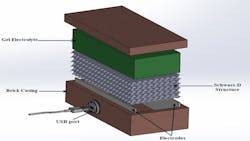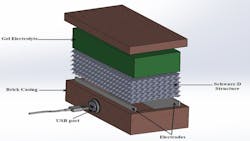Most of us are familiar with galvanic cells, although we may not use that terminology. These most typically are devices consisting of two dissimilar metal electrodes immersed in an electrolyte, a non-metallic chemical compound – usually a liquid or gel – that dissociates into ions and can conduct an electrical charge.
We’re referring, most commonly of course, to the lead-acid battery. Some of us first learned about galvanic cells by making lemon (or potato) batteries in 8th grade science class, where we inserted pieces of zinc and copper (the electrodes) into a lemon, and measured the voltage (electromotive potential) between them. In that case, the lemon juice was the electrolyte.
In galvanic cells, electricity is derived from an electrochemical reaction. There are also thermogalvanic cells, which are galvanic cells in which heat is used to provide electrical power. In those cells, the two electrodes are deliberately maintained at different temperatures. This temperature difference generates an electromotive potential between the electrodes, which in thermogalvanic cells can be of the same metals.
A team of scientists from King’s College in London, Arizona State University, and the University of New South Wales in Sydney, Australia – all part of the PLuS Alliance – have now developed a thermogalvanic brick that generates electricity when the two exposed faces of the brick are maintained at different temperatures. If a shelter was built using these bricks, and the exterior wall was exposed to the sun so that it was hot, while the interior side of the wall was shaded and cooler, electricity would be produced. For housing in developing countries (or even temporary housing in refugee camps), where electricity is either unavailable or, at best, unreliable, this could significantly improve the quality of life for those residents.
A regular contributor to HPAC Engineering and a member of its editorial advisory board, the author is a principal at Sustainable Performance Solutions LLC, a south Florida-based engineering firm focusing on energy and sustainability.
About the Author
Larry Clark
A member of HPAC Engineering’s Editorial Advisory Board, Lawrence (Larry) Clark, QCxP, GGP, LEED AP+, is principal of Sustainable Performance Solutions LLC, a South Florida-based engineering firm focused on energy and sustainability consulting. He has more than two dozen published articles on HVAC- and energy-related topics to his credit and frequently lectures on green-building best practices, central-energy-plant optimization, and demand-controlled ventilation.

